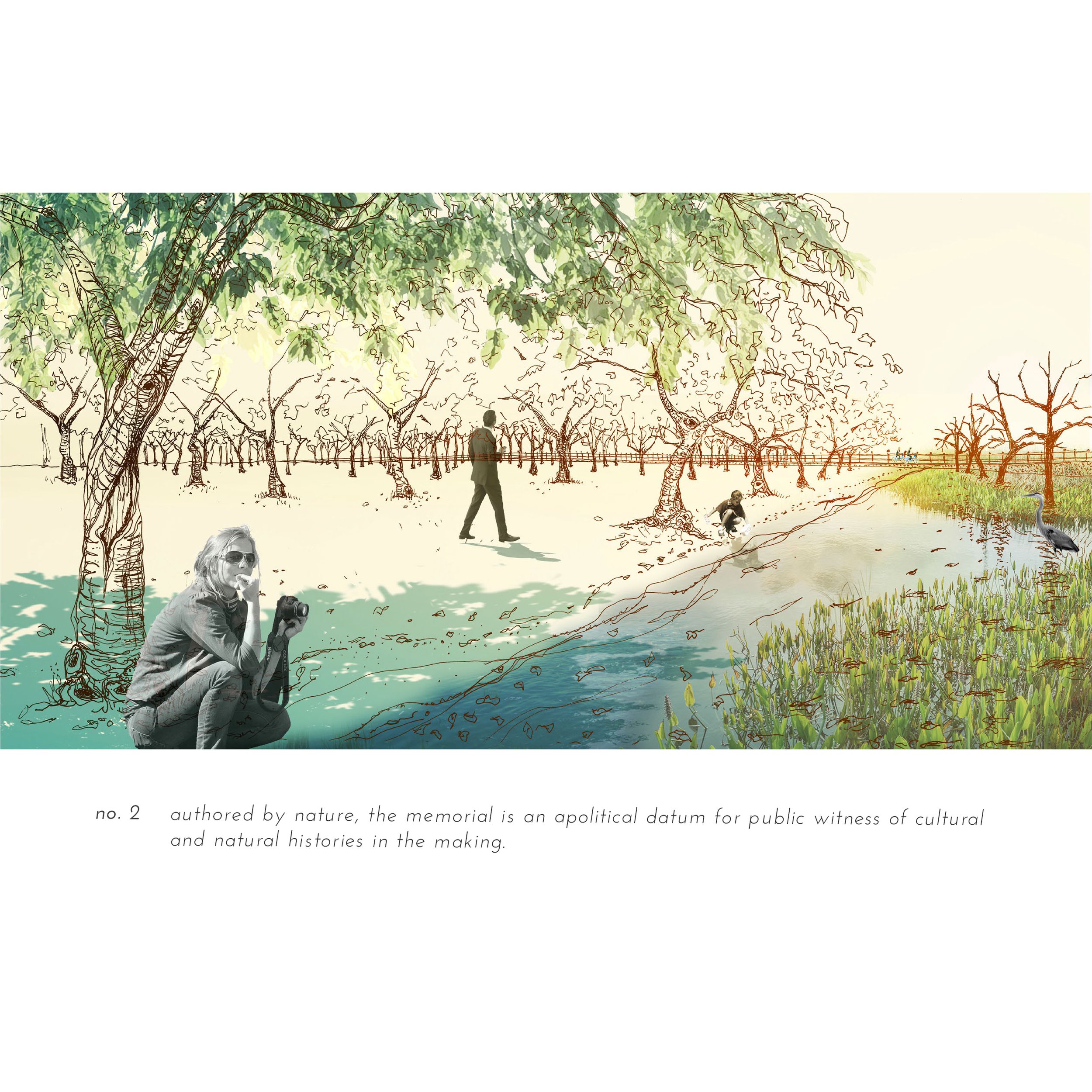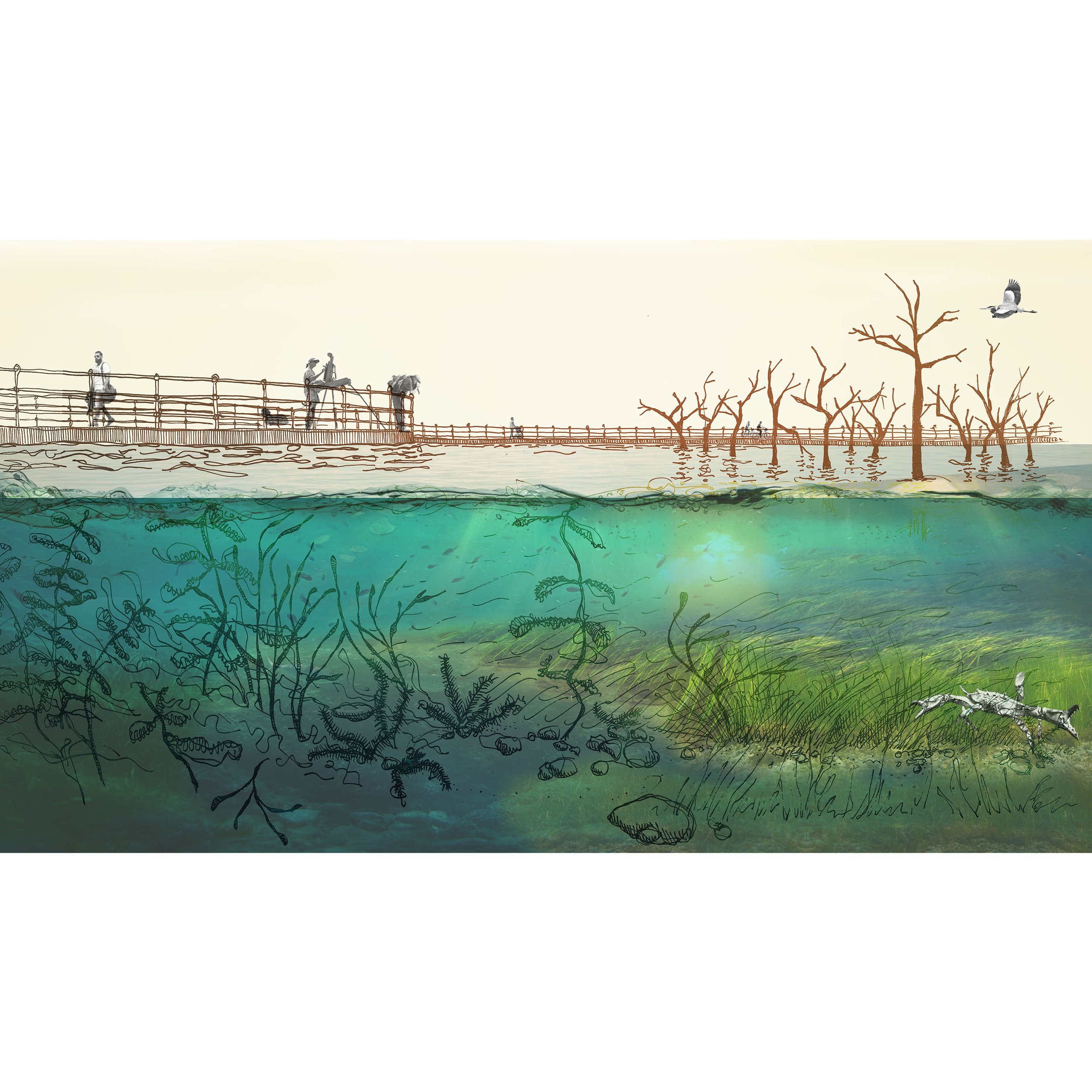
Climate Chronograph
A climate memorial and sea level rise observatory.
Climate Chronograph sacrifices a grid of cherry trees to rising seas. As oceans swell with ice melt and thermal expansion, trees flood on the sloped shore—dying row by row—leaving sculptural trunks that delineate shorelines of the past.
Authored by nature, the memorial is an apolitical datum of cultural and natural histories in the making. As a processional gauge of advancing seas, Climate Chronograph reframes the climate debate in the irrefutable language of the land and sea for public witness in real time.
As a memorial on the National Mall, Climate Chronograph essentializes climate adaptation and mitigation as both a planetary and hyper local dilemma and opportunity for Washington D.C., a low-lying seat of global power, where political might, civic vulnerability and commemorative significance coincide in one bustling precinct.
Climate Chronograph is a contemplative forum for our collective alarm and optimism over our human fragility and power . . . a shoreline from which to observe the linked fates of our species and the climate upon which we both act and rely. Marking today’s rising seas through a lens of tomorrow, the memorial previews a hindsight-like reckoning in our agency in climate change acceleration or remission.
Future climate history is ours to compose today.
design
Erik Jensen + Rebecca Sunter (as Azimuth Land Craft)
competition winner
Memorials for the Future (NPS, NCPC, Van Alen Institute)
location
National Mall, Washington D.C.
date
October 20, 2016







Climate Chronograph is the unbuilt winning entry to the Memorials for the Future ideas competition, sponsored by the National Capital Planning Commission (NCPC), Van Alen Institute, and the National Park Service (NPS).
Climate Chronograph died in all but idea just three weeks after its debut with the 2016 administration that ended climate work, despite wide-ranging enthusiasm for construction from both D.C.'s local and national leaders—including Directors of NPS, NCPC, U.S. Commission of Fine Arts (CFA), and the National Endowment for the Arts (NEA).
Washington D.C. is among the more vulnerable of the world’s waterfront regions facing ocean inundation, as it was built on wetland and river infill. The island began flooding on King Tides years ago, causing infrastructural damage to the island's perimeter which is a keystone in downtown D.C. 's flood control. In 2012, the Trust for the National Mall invested $13.5 million in seawall improvements around the Jefferson Memorial on the northern end of the island. NPS was excited about Climate Chronograph's construction as the island’s owner in order to bring visibility to the unique challenges a fluctuating environment poses to NPS’ preservation-stewardship mission here and across the National Park system as well as to highlight more broadly the defense vs. retreat financial conundrum faced by waterfront communities the world over.
While the National Mall is a fittingly poignant location, the memorial's concept remains indelible as paper architecture or on any stretch of tidal shore.
As of 2024, 8 years have passed since 2016’s Climate Chronograph inception, and
sea level has risen 14.95 mm, over 1/2-inch.
According to NOAA Climate + University of Hawaii Sea Level Rise Center
https://www.climate.gov/news-features/understanding-climate/climate-change-global-sea-level
https://uhslc.soest.hawaii.edu/data/?fd
by press, poets, + philosophers
“A message written in the future perfect tense, Climate Chronograph transforms the present into an object of future memory.” Elizabeth Rush, RISING Dispatches from the New American Shore, Pulitzer Prize finalist
“Climate Chronograph . . . is a forward-looking memorial that takes a complex global process—climate change—and turns it into a tangible, personal experience.” National Park Service
“In part, the memorial is meant as a commentary on modern attempts to control nature, and what that means in an era of climate change.” Fast Company
“The project [Climate Chronograph] is . . . one of the first intentional memorials of the Anthropocene, designed in reaction to political impotence . . .” Dr. Clara de Massol, Remember the Anthropocene. Memorials Beyond the Human, 2024
“A Sinking Cherry Grove Portends a Future of Rising Tides” HYPERALLERGIC
“Climate Chronograph carries all of its past in its present, as it becomes its future.” Dr. Clara de Massol, Remember the Anthropocene. Memorials Beyond the Human, 2024
“Climate Chronograph demands that we reflect, now, on whether we will have wished we had done more to slow the incoming tide.” Elizabeth Rush, Orion Magazine, January/February 2017
“Climate Chronograph . . . repurpos[es] a portion of East Potomac Park in Washington, DC, as a place for visitors to kayak among the dead cherry trees, left behind as persistent sea level rise subsumes the land.” Contemporary Memorials: Spaces of Engagement, Calls to Action - Harvard Graduate School of Design
The finalist concepts allow us to think outside the often-fixed nature of memorial design, looking beyond solemn marble statues of uniformed men on horseback, and envisioning emotionally resonant memorials open to varied interpretations.’” CURBED Washingston, D.C.
“Climate Chronograph is a new form of memorialization that commemorates the aftermath of the present.” Professor Edward Linithal
“With Climate Chronograph, Sunter and Jensen do not aspire to preserve or encase the memory of what is being lost to planetary climate change, instead . . . the memorial is designed to follow the movements of climate change organically by acting, in the manner of counter monuments as defined by James E. Young, ‘against itself’. Climate Chronograph counters memorial traditions of perennialism by unsuspending the past from its monumental shrine. . . . The memorial is not designed to reassure but to challenge its visitors and remind them of their agency and situation in the formulation and perpetuation of climate change’s collective memory. . . . Climate Chronograph is not devised to ‘solve’ climate change but to expose its material and immaterial reality . . .” Dr. Clara de Massol, Remember the Anthropocene. Memorials Beyond the Human, 2024
“Climate Chronograph [has become] a . . . memorial of the Trump era, significative of the former administration’s refusal to recognize the reality of climate change. The project won the Memorial for the Future competition just before Trump’s election in 2016; if it had been erected, it would have gone against the denialist narrative of its country’s executive leader. . . . {T}he project is . . . one of the first intentional memorials of the Anthropocene, designed in reaction to political impotence . . .” Dr. Clara de Massol, Remember the Anthropocene. Memorials Beyond the Human, 2024
“II
A grove of cherry trees
will be planted in rows
on a graded field,
close to the water.
As sea levels rise, salinity
in the soil will kill
the trees, row by row,
moving up slope foot by foot
until they all wither.
I hope to have a daughter
to take there, someday. Dress her
for a picnic in the Capitol,
tie her curls up in bows.
Wet the soles of our shoes
as we toe the line where cherry
blossoms once thrived. Uphill,
we will find few remain.”
excerpt Memorials for the Future, Climate Chronograph, Project Muse